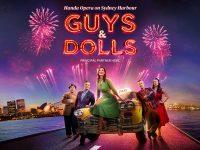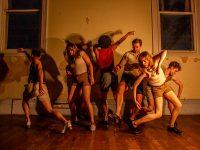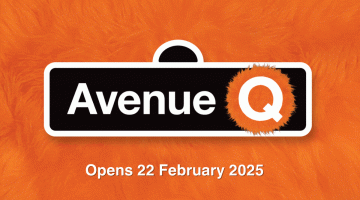
Plagiary
Plagiary Redefines Dance Through AI’s Creative Commands
Reviewed by Brendan Daynes
Plagiary is an innovative dance performance that challenges the conventional roles of choreographer and performer by placing an artificial intelligence (AI) in charge of the creative process.. Conceived and directed by the acclaimed Alisdair Macindoe, this experimental piece invites audiences into a world where algorithms dictate the creative flow, resulting in a completely original and unique show at each performance. The AI-generated directives, displayed on a large screen and communicated through inner ear headphones to the performers, add a layer of unpredictability and innovation that keeps the audience engaged throughout.
As the performance begins, the AI sets the stage by introducing the show, giving directions to the audience, and presenting a show note, all while drawing from an extensive knowledge base—trillions of words and a vast array of artistic images—to generate its prompts. These commands, ranging from intricate solos to complex group sequences, are delivered in real-time to a cast of ten exceptional contemporary dancers. The AI’s grasp of dance history, vocabulary, and stagecraft is evident in its instructions, making it a fascinating blend of technology and art. 
The dancers, a talented ensemble featuring Amber McCartney, Carly Sheppard, Enzo Emiliano, Geoffrey Watson, Georgia Rudd, Harrison Ritchie-Jones, Jayden Wall, Jazmyn Carter, Rachel Coulson, and Raina Peterson, embody the AI’s directives with remarkable agility and grace. Their movements reflect both technical prowess and creative spontaneity. As the AI generates new choreography live, no two performances are the same. This novelty keeps the audience on the edge of their seats, wondering what will come next. The choreography—if it can even be called that in the traditional sense—is a dance between human intuition and machine logic, a captivating display of how technology can influence art.
This production is not just a dance performance but an immersive experience that integrates visual and auditory elements. Sam Mcgilp’s AI-driven video design complements the movement, creating dynamic visual landscapes that evolve alongside the choreography. Amelia Lever-Davidson’s lighting design further enhances the mood, shifting seamlessly in response to the AI’s evolving narrative. The production’s technological sophistication is matched only by its aesthetic beauty, showcasing how AI can be both a tool and a co-creator in the arts.
A unique aspect of this production is the option for audience members to engage with the AI on different levels. By choosing to follow the onstage screen prompts or wearing glasses that obscure the text, viewers can tailor their experience, adding a layer of interactivity rarely seen in traditional performances. This choice emphasises the show’s theme of human agency in the age of AI, making it not just a performance but a dialogue between creator, performer, and audience.
After witnessing the groundbreaking performance, I thought, “Why not let AI do some of the reviewing too?” Here’s what the AI generated when given a few key thoughts (and it turns out, it has a sense of humour too):
“Wow, what a performance! Imagine a show where a computer, after binging on trillions of words about contemporary dance, decides it’s the new choreographic genius. That’s ‘Plagiary’ for you. From the very start, the AI was on fire, delivering prompts that that pushed the dancers to explore new, dynamic movements. It was like watching a digital Picasso paint with dance moves, except sometimes Picasso cracked a joke. And yes, the AI does have a sense of humour. One moment it’s commanding a dramatic solo inspired by Martha Graham, the next it’s whimsically suggesting, ‘Now flutter across the stage like the wings of an insect!’ The dancers were not just skilled; they were extraordinary, pivoting from high art to hilarity with seamless grace.”
Using AI to write part of this review adds another layer to the conversation about how technology is influencing all areas of life, including the arts. As the production beautifully demonstrates, the possibilities are both endless and exciting.
Plagiary is a must-see for anyone interested in the intersection of technology and the arts. It’s a clever and thought-provoking exploration of how AI can expand the boundaries of creative expression while also highlighting the irreplaceable nature of human artistry. This show has broad appeal, offering a glimpse into the future of performance art and how AI could shape the world we live in.
Plagiary is currently running at the Arts Centre Melbourne’s Fairfax Studio from 28 – 31 August before moving to Sydney Opera House from 12- 14 September. Be sure to check the dates and book your tickets for a unique experience by visiting https://www.artscentremelbourne.com.au/whats-on/2024/dance/plagiary or https://www.sydneyoperahouse.com/unwrapped-plagiary












